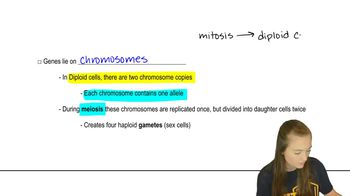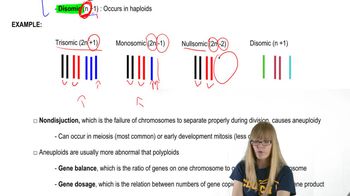Table of contents
- 1. Introduction to Genetics51m
- 2. Mendel's Laws of Inheritance3h 37m
- 3. Extensions to Mendelian Inheritance2h 41m
- 4. Genetic Mapping and Linkage2h 28m
- 5. Genetics of Bacteria and Viruses1h 21m
- 6. Chromosomal Variation1h 48m
- 7. DNA and Chromosome Structure56m
- 8. DNA Replication1h 10m
- 9. Mitosis and Meiosis1h 34m
- 10. Transcription1h 0m
- 11. Translation58m
- 12. Gene Regulation in Prokaryotes1h 19m
- 13. Gene Regulation in Eukaryotes44m
- 14. Genetic Control of Development44m
- 15. Genomes and Genomics1h 50m
- 16. Transposable Elements47m
- 17. Mutation, Repair, and Recombination1h 6m
- 18. Molecular Genetic Tools19m
- 19. Cancer Genetics29m
- 20. Quantitative Genetics1h 26m
- 21. Population Genetics50m
- 22. Evolutionary Genetics29m
6. Chromosomal Variation
Chromosomal Mutations: Aneuploidy
Problem 8f
Textbook Question
If the haploid number for a plant species is 4, how many chromosomes are found in a member of the species that has one of the following characteristics? Explain your reasoning in each case.
Monosomy
 Verified step by step guidance
Verified step by step guidance1
Understand the haploid number: The haploid number (n) represents the number of chromosomes in a single set of the organism's genome. For this plant species, n = 4. Therefore, the diploid number (2n), which is the total number of chromosomes in a normal somatic cell, is calculated as 2 × n = 8 chromosomes.
Define monosomy: Monosomy refers to the loss of one chromosome from the diploid set. In a diploid organism, this results in a chromosome count of 2n - 1. For this plant species, the diploid number is 8, so monosomy would result in 8 - 1 = 7 chromosomes.
Explain the reasoning: Monosomy occurs when one chromosome is missing from the normal diploid set. This can happen due to errors during cell division, such as nondisjunction, where chromosomes fail to separate properly during meiosis or mitosis.
Relate to the haploid number: Since the haploid number is 4, the diploid number is 8. Monosomy reduces the chromosome count by one, resulting in 7 chromosomes. This is consistent with the definition of monosomy as 2n - 1.
Summarize the calculation: To determine the chromosome count in a monosomic individual, subtract one chromosome from the diploid number (2n). For this species, the calculation is 8 - 1 = 7 chromosomes.
 Verified video answer for a similar problem:
Verified video answer for a similar problem:This video solution was recommended by our tutors as helpful for the problem above
Video duration:
1mPlay a video:
Was this helpful?
Key Concepts
Here are the essential concepts you must grasp in order to answer the question correctly.
Haploid and Diploid Numbers
The haploid number (n) refers to the number of chromosomes in a gamete, which is half the total number of chromosomes in a diploid organism. In this case, if the haploid number for the plant species is 4, the diploid number (2n) would be 8. Understanding these terms is crucial for determining chromosome counts in various genetic scenarios.
Recommended video:
Guided course

Diploid Genetics
Monosomy
Monosomy is a type of aneuploidy where one chromosome from a pair is missing, resulting in a total of one less chromosome than the diploid number. For a plant with a diploid number of 8, monosomy would mean that one chromosome is absent, leading to a total of 7 chromosomes in that individual. This concept is essential for analyzing the genetic implications of chromosome loss.
Recommended video:
Guided course

Aneuploidy
Chromosome Structure and Function
Chromosomes are structures within cells that contain DNA and proteins, playing a critical role in heredity and gene expression. Each chromosome carries specific genes that determine traits. Understanding chromosome structure helps in grasping how changes in chromosome number, such as those seen in monosomy, can affect the organism's development and function.
Recommended video:
Guided course

Chromosome Structure
Related Videos
Related Practice
Textbook Question
For a species with a diploid number of 18, indicate how many chromosomes will be present in the somatic nuclei of individuals that are haploid, tetraploid, trisomic, and monosomic.
572
views


